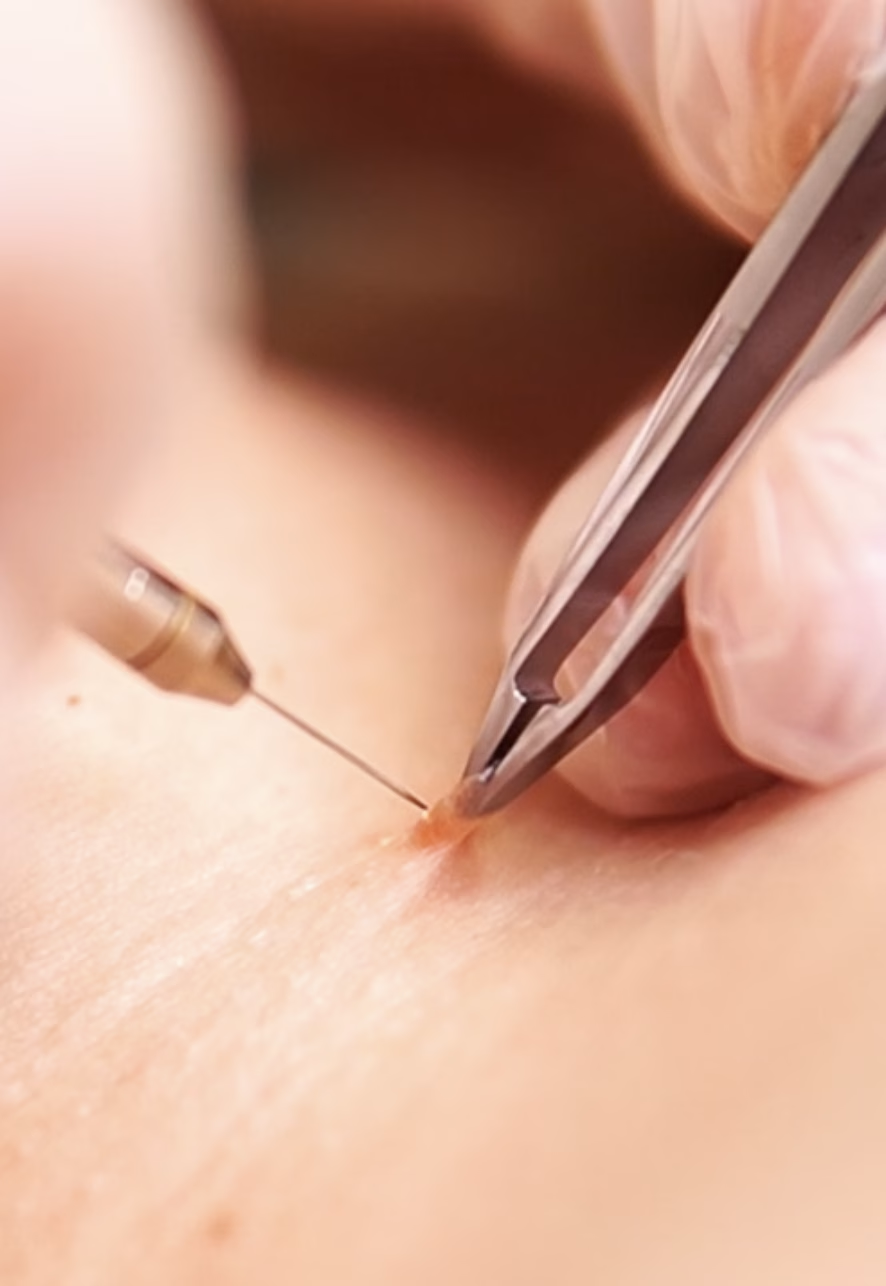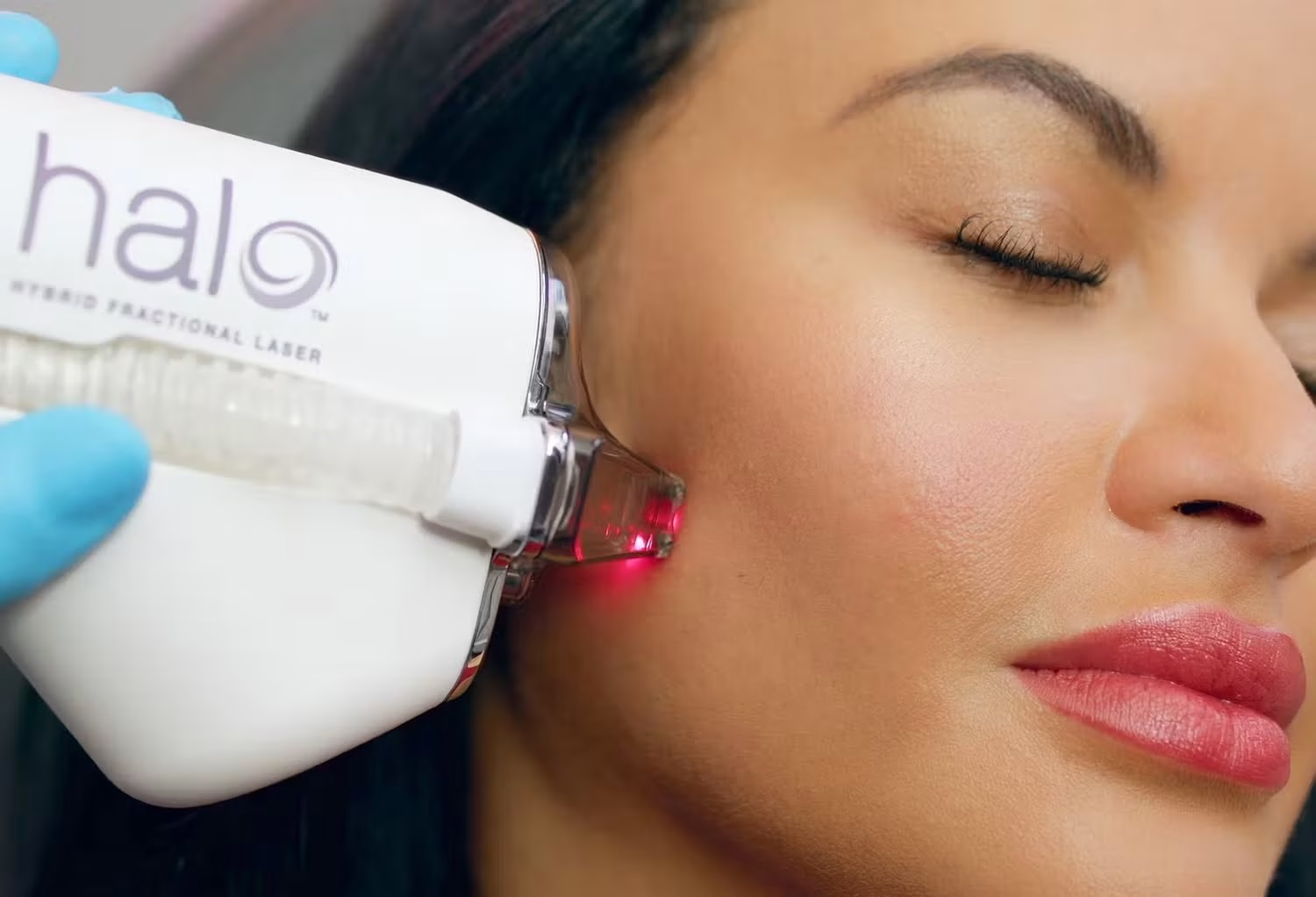
Skin tags: effective removal solutions
Skin tags are small flesh-colored or light brown growths, similar in tone to moles.
While harmless, these small growths are often disliked by individuals, either because they can be uncomfortable or purely for aesthetic reasons (for example, skin tags on the eyelids). At Victoria Park Medispa, they can be treated with minimally invasive medical aesthetic treatments, allowing you to remove them and restore smooth skin.
What causes
the appearance of a skin tag?
A skin tag, also known as a molluscum pendulum, is a flesh-colored growth connected to the skin by a thinner base called the peduncle. Unlike pigmented spots or moles, skin tags are always protruding, forming a small sphere that extends from the skin. Their texture differentiates them from warts: while warts are generally rough, these skin tags are smooth and softer. They are not contagious or related to the human papillomavirus (HPV), unlike warts. In fact, skin tags are purely cosmetic and pose no danger. However, if you are wondering how to remove a skin tag, it is always wise to have them identified by a healthcare professional to confirm their nature.
The exact causes of skin tag formation remain unknown, though some hypotheses exist. While not confirmed, it may involve a disruption in the cells that form sebaceous glands, which produce the skin’s protective oily film. Genetic factors are also considered a potential cause, though this theory is not validated either. Skin tags often appear in body folds, such as under the arms, in neck creases, or beneath the breasts. They can also form under certain conditions, such as in individuals who are overweight, suffer from obesity, have high blood pressure, diabetes, or are pregnant.
Lastly, skin tags are more commonly found in adults over 40 years old. People often seek to have a skin tag removed because it may be uncomfortable, especially if located in an area where the skin experiences frequent friction. Alternatively, removal may be desired for aesthetic reasons. In either case, consulting a healthcare professional at a medical aesthetics center is recommended.
Differentiating skin tag varieties
There are various types of skin tags: some resemble flesh-colored or brown moles that extend from the skin’s surface. Others appear red and are known as angiomas.

Discover liposuction
Liposuction is a surgical procedure offered at Victoria Park Medispa to eliminate localized fat deposits resistant to diet and exercise.
- Modern techniques.
- Personalized consultation.
- Optimized post-operative care.
- Safe procedure.
- Firmer and more toned silhouette.
- Reduction of localized cellulite.
- Visible transformation.
Acrochordon: Possible Treatments
To remove a skin tag, there are over-the-counter solutions available at pharmacies, such as topical products. However, it is more prudent to rely on professional care to analyze the issue and determine the safest and most suitable solution. Among the possible treatments to remove this skin growth, fractional laser therapy is one of the non-invasive options offered at Victoria Park Medispa.
This type of laser is applied to the skin by the professional in charge of the treatment, creating microscopic wells of heat. The targeted cells are destroyed and then replaced by new, smooth skin tissue. The second solution involves removing the skin tag through a surgical procedure called excision. This operation is performed by a healthcare professional under local anesthesia. To avoid a highly visible scar, the healthcare professional reconstructs the area aesthetically, especially if the skin tag is located on the face.
HALO LASER
Give your skin a new lease on life by improving its elasticity, eliminating fine lines and signs of aging, with the Halo laser treatment.
ESTHETIC EXCISION
Learn how esthetic excision effectively treats various skin lesions such as skin tags, moles, or cysts safely.

Before and After Skin Tag Treatment
First and foremost, it is necessary to meet the healthcare professional at Victoria Park Medispa responsible for removing the skin tag. During this appointment, the professional collects information about the patient’s health condition, analyzes their skin, and discusses their expectations. This is followed by the creation of a treatment plan. Depending on whether the laser or excision option is chosen, the healthcare professional provides recommendations to ensure the patient is well-prepared for the session. In all cases, patients are encouraged to ask any questions they have to fully understand the specifics of the chosen treatment.
On the day of the treatment, if fractional laser therapy is chosen, the area of skin to be treated may be numbed with anesthetic cream to reduce the sensation of heat during the procedure. The session typically lasts around 30 minutes. Afterward, the skin may appear red and swollen for 3 to 7 days. It should then be exfoliated to remove dead skin layers and protected from sun exposure. Note that the number of sessions required to eliminate all skin tags may vary from person to person.
If excision is chosen, the Victoria Park Medispa professional administers local anesthesia to the skin before removing the small skin tag. Using an electrical device, the professional cauterizes the wound and seals small blood vessels, reducing bleeding and promoting healing. Follow-up care is scheduled in the days following the procedure (the timeline varies depending on the treated area) to ensure proper healing and check for any signs of infection.
In Summary
A skin tag, also known as molluscum pendulum, is a benign skin growth often shaped like a small ball attached by a stalk. These growths are typically the same color as the skin or slightly brown and are neither dangerous nor contagious. However, they can be bothersome or unsightly, particularly when located in visible areas such as the eyelids.
The exact causes of skin tags are not fully understood, but they may be linked to a dysfunction of sebaceous glands or genetic factors. They are more common in overweight individuals, those with hypertension or diabetes, and pregnant women. Skin tags often form in body folds, such as under the armpits, around the neck, or beneath the breasts, and they become more frequent with age, particularly after 40.
Victoria Park Medispa offers two main options: fractional laser treatment and surgical excision. The fractional laser destroys skin tag cells using microscopic heat points, promoting the regeneration of smooth skin. Excision, performed under local anesthesia, involves removing the skin tag with an electrical device, cauterizing the wound to minimize bleeding and optimize healing.
Before the treatment, a consultation is necessary to assess the nature of the skin tag and discuss the patient’s expectations. After a laser session, the skin may be red and slightly swollen for 3 to 7 days, requiring gentle exfoliation and rigorous sun protection. In the case of excision, it is important to follow the professional’s instructions for wound care and schedule a follow-up to ensure proper healing.
Skin tags, cysts; aesthetic conditions treated at Victoria Park Medispa
It is relatively common for irregularities to form beneath the skin, altering its surface. This is the case with cutaneous cysts and stretch marks, which can impact self-perception and sometimes create insecurities. However, modern technologies can significantly reduce their appearance and, in some cases, eliminate them entirely.
For cysts, Victoria Park Medispa offers excision, which, like the treatment for skin tags, effectively removes them. It is then possible to even out the skin surface by remodeling it with fractional laser technology. Moreover, when combined with DP4 microneedling, this therapy can be an excellent option for individuals looking to reduce the appearance of stretch marks. By stimulating collagen production and targeting the cells responsible for the skin’s damaged appearance, the laser promotes the regeneration of smoother and more uniform skin.

Facial care
Explore the best facial care to improve the appearance and health of your skin with safe and innovative techniques.
Decollete aesthetics
Discover aesthetic treatments for the neck and décolleté to improve the elasticity and texture of your skin.
Liposculpture
Victoria Park Medispa offers liposculpture, a surgery to reshape the body for a balanced and harmonious silhouette.
Women’s health
Every stage of life can impact women’s health. Discover the various vaginal conditions and their treatments offered at Victoria Park Medispa.


